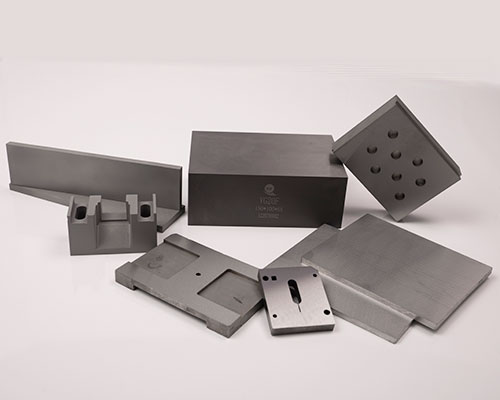What are the commonly used alloy new materials hard materials?
Hard materials include hard alloys, hard materials include hard alloys and include tungsten carbide powder, tantalum carbide, vanadium carbide, chromium carbide, tungsten carbide powder of the alloy, tantalum carbide, vanadium carbide, chromium carbide, titanium carbide, such hard powders as carbide powder, and diamond (titanium carbide, such hard powders as carbide, and diamond (C), Polycrystalline drill) cubic boron nitride, PcD (polycrystalline drill), cBN (cubic boron nitride), and Si3N4 silicon nitride. Si3N4 silicon nitride. PcD (polycrystalline drill) is a synthetic material that uses diamond particles mixed with a chemical binder and deposited into a coherent structure under high temperature and pressure. After that, artificial materials with coherent structures are deposited under high temperature and pressure. cBN (cubic boron nitride) is a polycrystal derived from PcBN. PcBN is a polycrystal made of cBN (cubic boron nitride) which is derived from PcBN. PcBN is a kind of polycrystalline cBN particles of PcBN and ceramic or metal catalyst binder deposited at high temperature and high pressure poly cBN particles and ceramic or metal catalyst binder deposited at high temperature and high pressure.
Si3N4 silicon nitride is a kind of ceramic material with high crushing resistance. Si3N4 silicon nitride is a kind of ceramic material with high crushing resistance. Silicon nitride is a ceramic material with high crushing resistance, carbide and carbon-nitrogen compounds -- although high speed steel is still very important for applications such as drilling carbide and carbon-nitrogen compounds -- although high speed steel is still very important for applications such as drilling and broaching, drilling and broaching, most metal cutting is done with carbide tools. The cutting is done with carbide tools. For materials that are very difficult to process, hard metals are now being replaced by nitrogen compounds, processed materials, hard metals are now being replaced by nitrogen compounds, ceramics and superhard materials. Carburized (or sintered) ceramic products and superhard materials. Carburized (or sintered) hard alloys and nitrogenous compounds, which are agreed by most of the world to be hard alloys and nitrogenous compounds, metals, are a series of very hard metals made by powder metallurgy technology, is a series of very hard, refractory, wear-resistant alloys made by powder metallurgy technology. Refractory, wear-resistant alloy. Tiny hard alloy or nitride particles are "cemented" by a metal binder when they are in a liquid at the sintering temperature. The composition and properties of individual hard metals are different from those of brass and high speed steel. The composition and properties of hard metals are different from those of brass and high speed steel. All hard metals are cermet, they're made of ceramic particles and metal bonding and all hard metals are made of a combination of cermet, ceramides. It is formed by the combination of coagulants.

Section 1 Cemented carbide
"Tungsten carbide" is a very hard carbide particle, especially tungsten carbide "is a very hard carbide particle, the appearance of tungsten carbide in the iron rich substrate makes high speed steel has excellent processing ability. Ability. Early hard alloys were too brittle for industrial use but it was soon discovered that tungsten carbide powder with about 10% of the metal, 10% of the metal was weak, but it was soon discovered that tungsten carbide powder with about 10% of the metal, such as iron, nickel or cobalt, was allowed to be sintered at about 1500℃. The billet is allowed to be sintered at about 1500℃. In this process, the resulting product has low porosity. In this process, the resulting product has low porosity, very high hardness, and considerable strength. Hardness, but also considerable strength. The combination of these properties makes the material ideal for use as a machining tool for cutting metals. The material is ideally suited to be used as a machining tool for cutting metal. ? Cemented carbide changes from copper welding cemented carbide embedding into clamp embedding, as well as the rapid development of coating technology. With the rapid development of embedding, as well as coating technology.
Method of making hard alloy tool materials: Method of making hard alloy tool materials: one is through press forging and sintering to the exact shape and size. Another advance is the application of high temperature vacuum solid cementing method HIP. (HIP) application. This method allows virtually all of the residual porosity in the carbide to be squeezed out by an inert gas under high pressure at an applied temperature of approximately sintering temperature. Extruded, applied at approximately sintering temperature. By this method stiffness, method stiffness, cracking strength and seismic performance can be increased by a factor of two or three, and the rejection rate of very large sintered parts can be reduced by a factor of three to a fraction of the previous level. To a fraction of previous levels.
The hardness of hard alloy depends on the content of hardening phase and grain size, that is, the higher the content of hardening phase, the finer the grain size, that is, the higher the content of hardening phase, the finer the grain size, the greater the hardness. It's also harder. The toughness of cemented carbide is determined by bonding metal, the higher the content of bonded metal, the greater the bending strength. The higher the content of bonded metal, the greater the bending strength. Hard alloy has high hardness, wear resistance, strength and toughness hard alloy has high hardness, wear resistance, good, heat resistance, corrosion resistance and a series of excellent properties, good, heat resistance, corrosion resistance and a series of excellent properties, especially its high hardness and wear resistance, even at 500℃, especially its high hardness and wear resistance, Even at the temperature of 500℃ is basically unchanged, 1000℃ still temperature is basically unchanged, at 1000℃ still has a high hardness. It has a very high hardness.